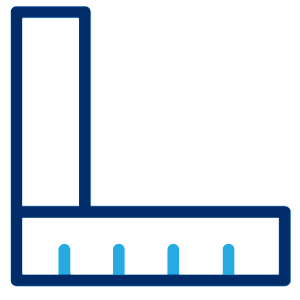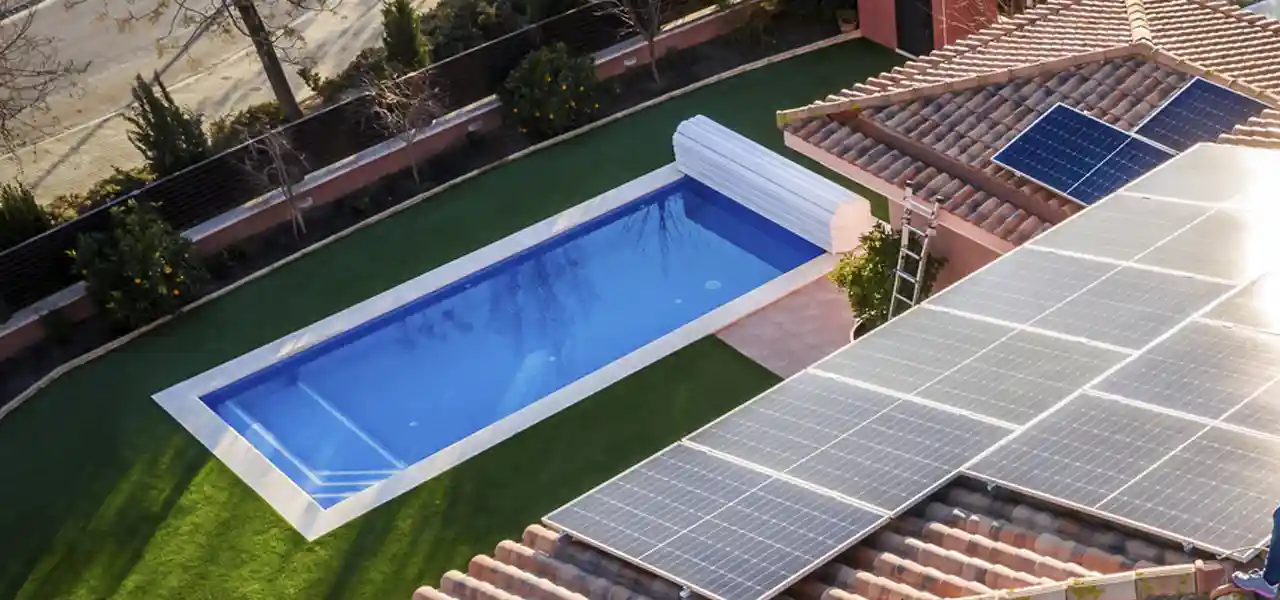When sizing a solar pool heater to a pool, we consider pool size, in area and gallons, your desired temperature gain, and other environmental factors such as wind and sun exposure. Solar pool heaters work well in all parts of North America, and in fact, many solar pool heater manufacturers are based in Canada, where solar pool heating is popular. But not all houses or yards lend themselves to solar heaters, because you need plenty of space for unobstructed sun for 4-6 hours per day.
Solar panels can be placed on a sunny roof of the house, garage or shed. A rack or shade structure can be built facing the sun. For smaller above ground pools, they can simply be put on the ground next to the pool. Here are the factors to look at when sizing a solar pool heater:
Pool Size

You should have half of the pool surface area in solar panels. The surface area of your pool is found when you multiply length by width of your pool. For example, a 16 foot by 32 foot pool would have 16×32=512 square feet of surface area. Round pools use the formula of pi times radius squared. For a 24-foot round pool, it’s 3.14 x144=452 square feet.
Panels are modular in that you connect them together. You can use panels that are 4’x10′ in size (40 sq. ft.) or the longer 4’x20′ panels (80 sq. ft.). The more panels you connect together, the more heat you can generate.
Here’s a solar panel sizing chart that you can use, based on installing roughly enough solar panels to equal half the pool surface areas.
For homes without optimum sun exposure or roof space for solar panels, consider these options:
- Build a pergola style structure on the sunny side of the pool.
- Build a solar rack with lumber into a sunny hillside.
- Build a solar rack in any sunny area within 100 feet of the pump.
Inground or Above Ground?
Above ground oval pools, without a deep end, have as much surface area as an equally sized inground pool, but without a deep end, there is much less water to heat. However, above ground pools have more heat loss through the sides or walls of the pool, which is reduced on inground pools. So, it may equal out.
Windy or Calm?
As with all of our pool heater types, we ask how much wind your pool receives. Pools in coastal or mountain areas, or other windy areas, may think about adding an extra solar panel to compensate for the wind’s heat theft. Using a cover or installing windblocks like fences or hedges can help reduce the problem.
Manual or Automatic?

Solar pool heaters can be operated with a solar controller, which increases performance and efficiency. It does this by bypassing the solar panels when conditions are not optimum for heating — during cloudy or rainy periods. Sensors monitor the temperature of the water and of the panels, and an automatic valve sends water to the solar panels when the sun is shining. A thermostat allows you to set a desired temperature for your pool.
Most above ground pools don’t install a solar controller, although they could. I always recommend the solar controller to anyone with a larger solar system, because it maximizes heat output and makes it automatic! Without a controller, heat losses offset heat gains during cloudy, rainy and windy periods of the day.
Those without a controller may want to add additional panels to offset the heat losses or plan to monitor it closely.
Covered or Uncovered?
A covered pool retains 70 percent or more of the heat put into it, much of which can be lost in cool overnight hours. If you plan to cover the pool consistently, you could install fewer solar panels than is recommended in the chart above.
Solar blankets, liquid solar blankets, or automatic pool covers will reduce the demand on the solar heater and allow you to install fewer solar panels or heat the pool in less than optimum sun exposure conditions.
Sunny or Shady?

The best conditions for solar are panels facing a southerly direction and receiving 5-7 hours of unobstructed sun per day. That’s not always possible, so if you have less, you could install more panels to compensate.
You can also place panels in different areas; they don’t all have to be all installed one array. They can be on different roof areas, or some panels can be rack mounted and others roof mounted. And they don’t need to be right next to the equipment either. You can run pipe underground to and from your solar panels.
The great thing about solar pool heating is that you can always add more panels. Another great thing is the free heat and no maintenance that these systems give.



I love all of the advice here, thanks. I have a16/32 inground in a tight yard. I have an 8*10 sunny south slope on my poolhouse to work with but that is all. Would there be any point installing a small array of panels?
Hi Jay, let’s see, 8×10, you could conceivably install 80 SF of 10 ft panels, or four 2’x10′ panels, although it might overhang a bit… but let’s say 80 SF of solar panels. Your pool size 16×32 = 512 SF. Ideally, 250 SF would be best, for big temperature rise. 80 SF however, I would expect to give as much as 10 degrees to the water. Perhaps more, during extended runs of sunny days, or less during extended runs of cloudy/rainy days. Using a solar controller is always best, to optimize heat gain, it will automatically send water to the panels only when it is sunny, and bypass the panels when conditions are not right – b/c… when you send water to the panels when they are not hot, it can actually cool the water. Which is a benefit to solar systems, if the water ever gets too hot, during summer, you can run the system at night, to cool down the pool.
Hi. I have a 15′ x 48″ above ground pool, with a 0.75hp, 3000gph pump/filter. I bought two 2′ x 20′ solar heater panels. Do I need to upsize my pump to work properly with the solar heaters?
Dan, probably not, you don’t need high speed water flow for solar to work, it’s the opposite actually. Give it a shot, you should be fine.
I have a 24’x48′ rectangular sports pool and like to heat it with solar. I have a great view of the southern sky. The pool is not too deep.
Hi, that’s a big pool, but still no problem for solar, as long as you can install enough panels to do the job. Recommended would be to have 50% of the pool square footage (1152), in solar panel square footage. So you would want almost 600 sq ft of solar panel, which is a lot of panels. Also would highly recommend the solar controller, to optimize heating times, and automatically turn it on/off. You could do less solar SF, if you did not need a 25° temperature rise. Say you did 400 SF, you could likely still get 10-15° temperature rise, which may be enough heat for you, depends on where you live and how long you want your season to be. Any other questions, email me at swimmers -at- intheswim.com
I have a 15′ round above ground pool. Would 2 solar heaters work for me? And do I install them myself?
Thanks so much,
Marilyn
Hi Marilyn, yes two heaters would be good size for a 15′ I think. Installation is really easy. You just need a few basic tools, to cut the return line and insert these in the hose, between the filter and the pool.
hi, i have a pentair variable flow pump with default settings (3 speeds) . are there issues in conneecting solar panels with a varialb pump?
Carlos, no known issues. Should be fine.
Hello,
I Just put in 7 solar panels. I am in Florida and trying to test the air and pool are both 85 degrees currently. How much heat will the panels be able to add in a day? Pool is 16×32
Thanks
Hi Kevin, I’m not sure of the output, but would love to hear a result of some experiments on your part, with a baseline measurement with no heating for 3-days, how fast and to what level can you raise the water temperature, with 7 pools, and a sunny Florida location. I would guess about 3-5 degrees per day
Hello! Does the amount of pipe to get to the house and up to the roof matter in seeing if my 1.0HP Hayward Matrix will be ok? I would need to run about 50ft of PVC to get to the house and then up two stories to reach the Southwest facing roof and then back. My filter is rated for the 1.5 HP pump as well if I need to upgrade.
Thanks
Well, the Matrix is an aboveground pool pump that doesn’t have the vertical lift ability of say the Superpump, or even better Tri-Star pump. The more powerful pumps will be better able to overcome the resistance of all that distance and height, and then push thru the panels and check valves. Matrix may do it, but if not, if the filter psi spikes too high, or water flow slows or the pump starts whining or smoking or something! THen you’ll know that you need a larger pump. a 1.5 hp should do it. You could use a variable speed pump as well, which will be required in July, 2021.
Hi Mark, my roof is 38 feet away from my pool and I have a 16” round above ground pool with a .6 Hp sand filter pump. Is that enough power to send water through the roof solar panels and sufficiently filter the pool water? Is the pressure effected? Thanks
Hi Marissa, you may have seen me say that larger pumps or booster pumps are not needed for mounting solar panels, well that is true for most INground pool pumps, but I’m afraid that your pump may be too small. And… you cannot just increase the pump size without increasing filter size, because the larger pump will blow dirt right thru the filter, and make water quality problems, or damage the filter, and raise the pressure very high, yes. At the same time, you dont need or want a powerful pump that would send the water through the panels too fast, a slow flow is best, so the panels dont cool too fast, or they cant heat up again after the initial few minutes of heat added to the pool. To make this work, I would suggest a small TRANSFER pump, very small 1/3 hp, like those listed on this page: https://www.globalindustrial.com/p/plumbing/pumps/utility-pumps/little-giant-non-submersible-utility-pump-115v-nickel-brass-head – and use a garden hose, and garden hose fittings, to run water from the pump to the panels and back (you can bury the hose, or if in a sunny area, use black hose, for a bit of added heat and keep it above the ground.
Hello,
I have a 16×28′ 18,500 gallon pool. How many panels should I get? and should I go up on my hp on my pump (I have a 1hp… should I go to 3 or 4 hp?) Thank you in advance…
Hi Jorge, definitely do not buy a new pump. Not necessary and will cause problems to increase the size of the pump. For the average pool with average sun exposure, we like to see a number of panel square footage to equal half of the pool surface area square footage. 16×28=448. So, try to get at least 200 – 225 sq. ft. of solar panel, This would be about 5 4×10′ panels or 3 4×20′ panels. Or some other calculation, if the panels are a different length or width.
Thank so you much Davy. I do have one more question. I read in some pool literature that some people have what is call a booster pump? That means a pump independently working to pump water to the roof vice your regular pool pump? Or can your regular pool pump do all the work? Thank you man! Cheers
In most cases, a good size INground pool pump of 1.5hp or higher can pump up to a second story with very little increase in pressure. For smaller pools, or aboveground pools, you may need a booster pump, but you don’t need a big one. Look at 1/3 to 1/2 hp TRANSFER pumps for aboveground pools, or small 3/4 hp or 1/2 hp, low flow pool pumps for inground systems. Solar heaters do not need a lot of flow to work well, only about 5 gpm through the panels.
Hi,
I have a 48 x 24 above ground pool with approximately 13,600 gallons.
How many panels do I need & I’m also hooked up with a salt system, will that hurt the solar panels?
No trees also
Thanks
Hi Salt will not hurt the panels. For a 24′ round pool, use 6 10′ panels, or 3 20′ panels.
We’re getting a 32×16 above ground pool. Live in Central Oregon. Springtime can be very warm mid 80’s and up. Summer mid to high 90’s pretty consistently with maybe above 100 for 3 or 4 weeks total.
How many solar panels would we need?
Sounds like nice weather! I would suggest two of the 20′ panels, or four of the 10′ panels, found herefound here
Hello!
We have someone recommending 4- 4×12 panels for our 28 foot above ground pool. He will be building a ground rack & we have no trees so it will be in the sun all day. We live in NJ & it’s basically calm where we are located. I’m worried that 4 panels isn’t enough from the research I’ve done & the other companies I’ve had come over to do estimates have said 8-9 panels! I really want to give him my business since he’s local & highly recommended. I’m confused???
Hi Andrea, it depends on how much heat you want I guess. It is often suggested to install enough solar panels to equal 1/2 of your pool surface area, but that is usually when talking about inground pools, with deep ends. Aboveground pools could go with 1/3 of your pool surface area, and still be able to get 20° F water temp increase, when needed. Your pool is 615 sf in area, 4 panels would be 192 sf – just about 1/3. Now you could go for 5 or even 6 panels, but I think 8 would be too much for your size pool.
I need a solar mat for an inground intex pool 16×32 holds 15,800 gallons of water.
Hi Vickie, for your size pool, you would want about 200-250 sq. ft. of solar panels. This would produce the most amount of heat. Of course any small amount helps.
what size pump is needed, how many gph is required ?
Hi Mark, for most pools and most solar systems, a booster pump or a larger pump is not needed, even if pumping water up onto the roof. And, a slow GPM thru the panels is best for heat absorption, something like only 3-5 GPM is perfect to balance absorption with re-heating, if the water goes too fast, the panels cool off too fast. Now for small intex pools, look at the Intex solar heater or the Suncoil heater. Larger aboveground pools or inground pools can use the Eco Saver solar panels. So, your pump gpm or gph is not going to be an issue, unless you use the wrong system, like using the small Intex heater on a larger aboveground pool, it could be damaged from high flow rates, or not heat well.